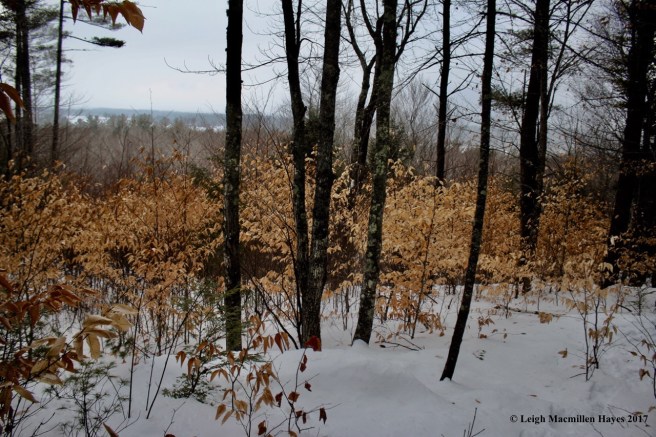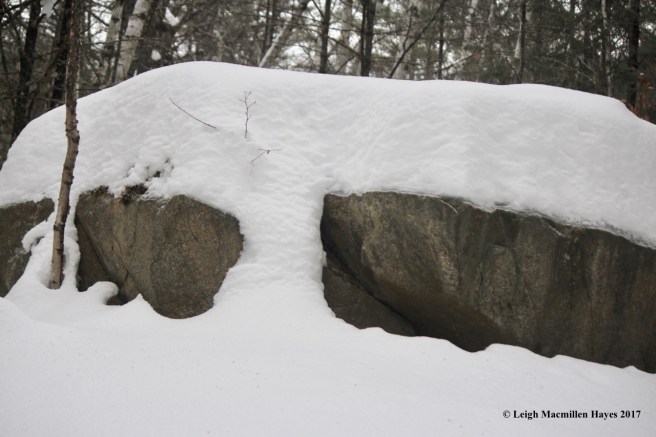Winter clothing? ✓
Hand warmers? ✓
Camera and extra lenses? ✓
Water? ✓
Trackards? ✓
Scat shovel? ✓
Snowshoes? Oh no. I didn’t realize until I met up with two fellow trackers for today’s Tuesday Tramp that I’d left my snowshoes home. “I’ll be fine,” I said. “Other’s have probably walked the trail before us.”
Indeed, they had. But I also knew that because we were tracking, we’d wander off trail. Indeed, we did.
It’s a good thing I had warm snow pants and tight boots on and brought along my sense of humor and adventure.

We began at the kiosk of the Greater Lovell Land Trust’s Chip Stockford property, where an Eastern Phoebe’s moss-lined nest awaits the return of its residents. Perhaps the funnel spider who took advantage of the nesting site is keeping the home fires lit amid the grasses and mud therein.

And then we reached the former log landing and the current site of Speckled Alders. We’d only seen squirrel evidence at that point, but knew to check on the fuzzy little woolly alder aphids who inhabit these shrubs.

We were surprised to see a black coating that seemed associated with the aphids and reminded us of black knot on fruit trees. Upon closer inspection, it appeared that the aphids were covered in black.
When I arrived home, I looked for more information and of course, Mary Holland, author of Naturally Curious, came to the rescue:
“Once leaves start to fall, one often observes white, fuzzy patches along the branches of Speckled Alder (Alnus incana). These fuzzy patches consist of colonies of aphids feeding on the sap of the shrub. In order to get enough nitrogen, they must drink volumes of sap, much of which is exuded from their abdomens as a sweet liquid called honeydew. The honeydew accumulates and hardens onto the branches as well as the ground beneath the shrub. Yesterday’s Mystery Photo was the honeydew of Woolly Alder Aphids (Paraprociphilus tessellates) which has been colonized by a fungus known as black sooty mold, a fairly common phenomenon.”
Fairly common means we need to pay more attention. That’s how it is in the natural world–you see something for the first time and then realize it’s everywhere, you’ve just missed it all your life, or at least up until now. I love the noticing.

In places we predicted, we found snowshoe hare runways. Typically, I give thanks to them for the technology that holds us up closer to the surface of the white fluff that covers our winter world.

Where the trail splits, we were greeted by the keeper of these woods. It was here that we also found porcupine tracks, the prints a bit muted but the sashaying pattern easily decipherable. We followed its trail for a while, me making post holes, but moving with relative ease. Winter hiking is so much easier even when the snow is deep.

We’d come to track mammals despite the freezing rain, sleet and snow, but other things also drew our attention, like the lines that decorate a beech tree. Usually it seems obvious that they are made by either a formerly attached vine or branches from other trees that scratched in the breeze. We couldn’t say for sure with this one, despite taking a closer look.

At the scenic look out, other young beech trees provided a hint of light in the gray of the day as we took in the sight of Lower Bay below.

A turn to the right and we noted a number of artist conks decorating a tree.

And beside our feet, evidence that a Ruffed Grouse had passed under low limbs.

For a while, our tracking seemed limited to squirrels and then at the old foundation, we noticed a bounding pattern. Of course, we needed to follow it, up over what was probably a rock and then noted where it had passed under a branch close to the snow. It was under the tree that its prints gave us a few more clues and we determined it was a fisher. (Note: Fisher, not Fisher Cat. They are members of the weasel family, not feline.)

As we rounded the bend below the foundation, snow snaking across the limbs of a downed tree made us pause and admire.

And then we paused again–at The Rock. In the summer, it’s a great place to admire “Life on a Rock,” and in the winter we always expect some small mammal to take advantage of its protection. One of these days maybe we’ll be rewarded with evidence.

It was just beyond The Rock that we decided to go off trail again and further explore the porcupine’s trail. It led us to its home and then climbed upward. My two companions went first, making their way across what we soon realized was an old stump dump.
Seconds later, I disappeared . . . down a hole . . . well, at least up to my waist! Our first thought as I pulled my body out–would I discover quills on my boots? Thankfully no. I maneuvered and my friend, Joan, who is half my size, pulled me up as we laughed about the possibilities.
We skedaddled across the rest of the dump and bushwhacked back to the alder trees.
So maybe I didn’t exactly disappear down a rabbit hole, but for a brief moment it felt like such. And will become part of our memory of a snowy, icy day spent on the prowl.

You must be logged in to post a comment.